The Samsung Galaxy S7 & S7 Edge Review, Part 1
by Joshua Ho on March 8, 2016 9:00 AM ESTSoC Performance
While we’re ready to move on to newer benchmarks for 2016, our system performance benchmarks from 2015 are still going to provide a pretty good idea for what to expect from the Galaxy S7 and Snapdragon 820 by extension. For those that are unfamiliar with what the Snapdragon 820 is, I’d reference our previous articles on the Snapdragon 820.
In essence, we’re looking at a 2x2 CPU configuration with 2.15 GHz Kryo cores for the performance cluster, and 1.6 GHz Kryo cores for the efficiency cluster. Binding the two clusters together are some power aware scheduling at the kernel level and a custom interconnect to handle coherency between the two clusters. Memory is also improved relative to the Snapdragon 810, with a bump to LPDDR4-1866 over the former's LPDDR4-1600. Of course, there's a lot more to talk about here, but for now we can simply look at how the Snapdragon 820 compares in our benchmarks.
Update: As we've had a few questions on the subject, I just want to clarify browser testing. Samsung's stock browser was not included with our Verizon-branded sample phone, nor is it possible to install it at this time. As a result we are unable to test the performance of Samsung's browser. The Verge reports that this is a Verizon decision and that all Verizon phones will be shipping like this; so for these phones Chrome is the de-facto stock browser.
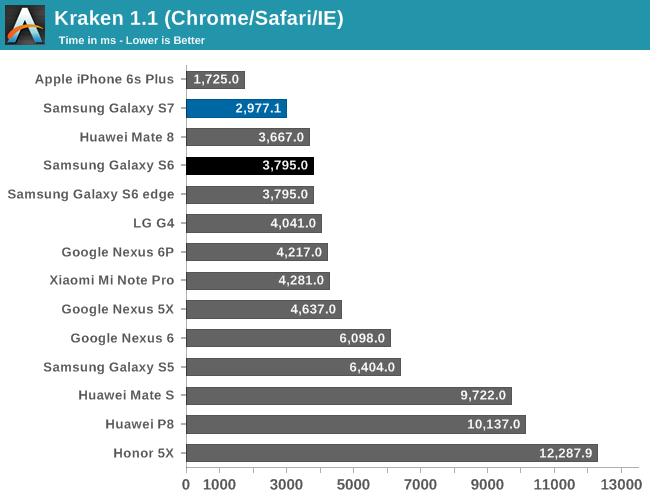

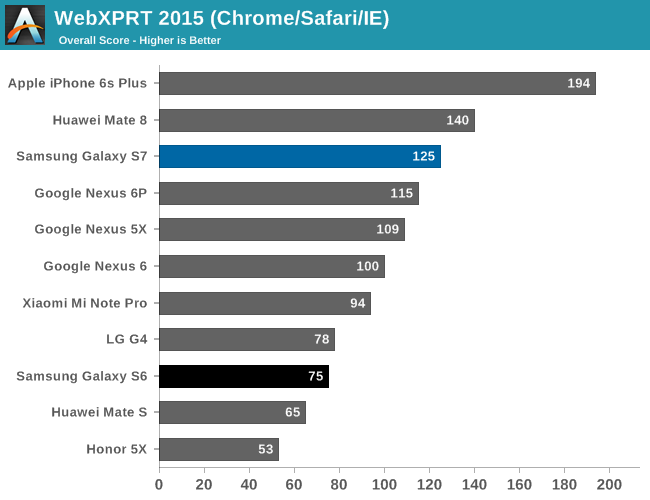
Starting off with our web benchmarks, we can see that in the time since our initial testing of the Snapdragon 820 MDP there have been some major improvements to how well Chrome is optimized for Kryo. As a result we're seeing results that are almost comparable to Snapdragon Browser in Chrome.
Overall then the Galaxy S7 and its Snapdragon 820 SoC won't top the charts on web benchmarks - Apple still holds an edge here - however the Galaxy S7 puts up a solid fight. The one drawback here is that the Mate 8 and its Cortex A72 CPU seems to have the edge over the Galaxy S7.
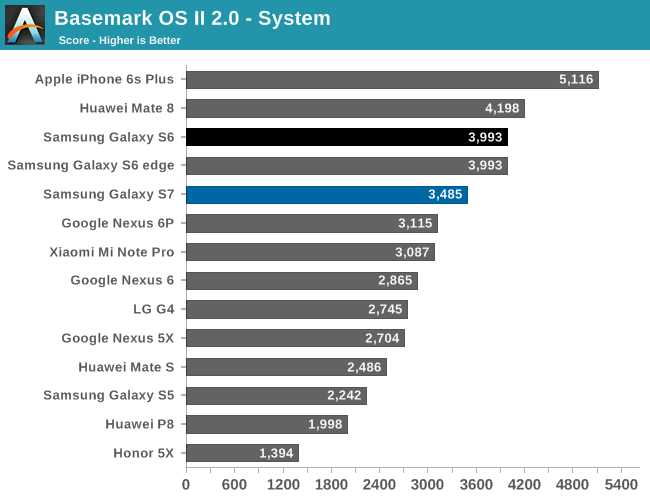
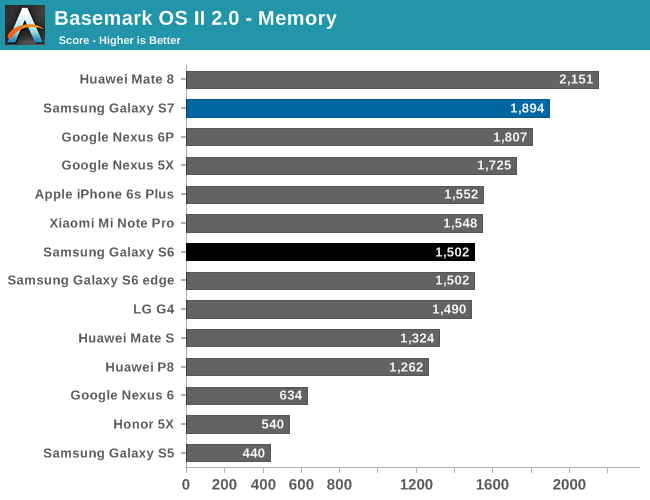
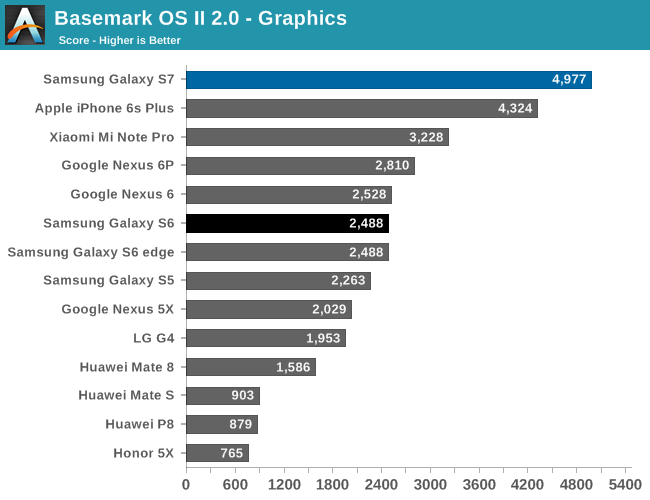
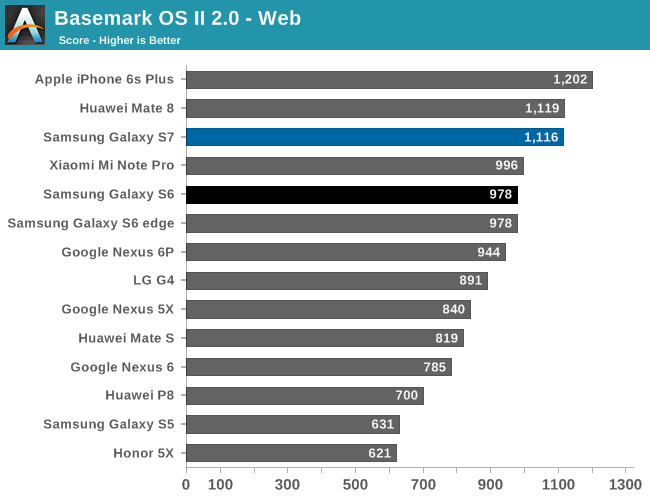
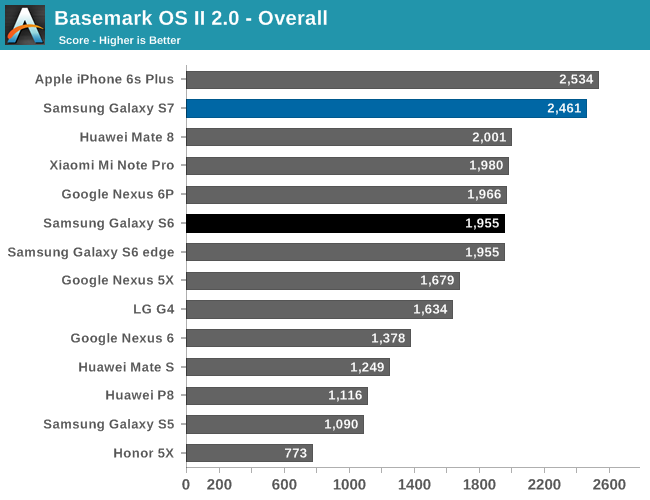
In Basemark OS II the combination of a better GPU, better NAND, and better single thread CPU performance seems to be enough for the Galaxy S7 to approach the iPhone 6s Plus in overall performance. While the system benchmark shows that Kryo isn't quite going toe to toe with Twister, the Adreno 530 helps to narrow the gap in the graphics test.
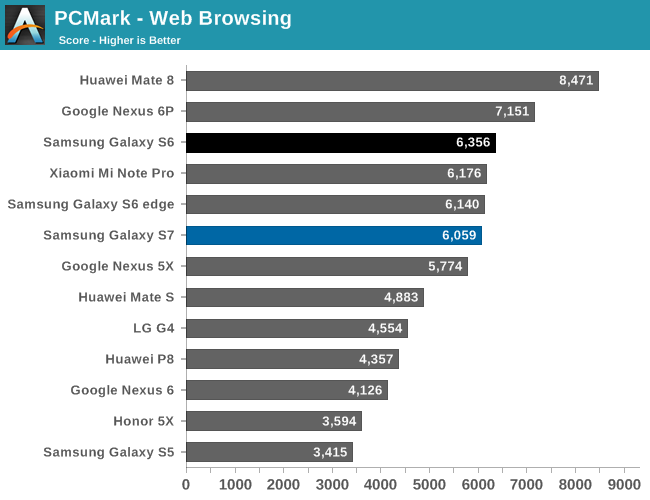
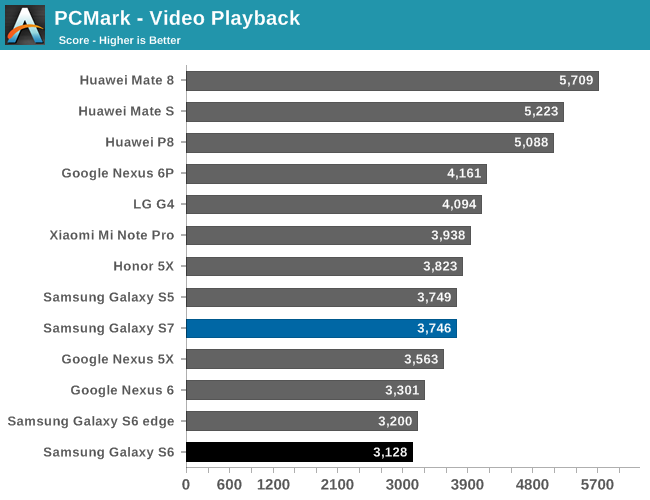


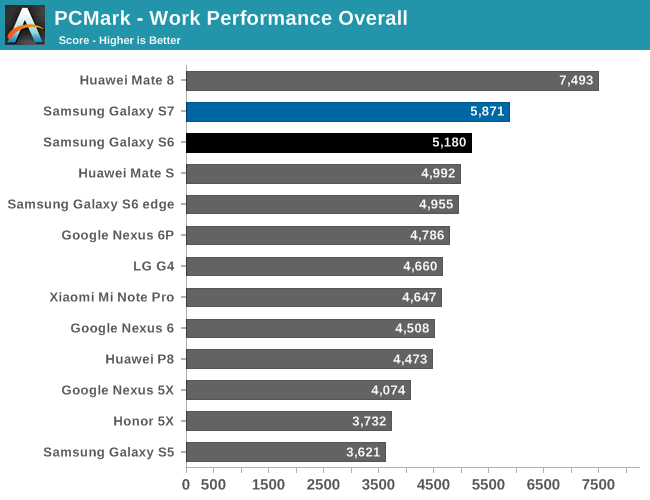
In PCMark, we can see that the Galaxy S7 is mostly comparable to the Galaxy S6. However major improvements in areas like GPU performance help to give it an overall advantage relative to the Galaxy S6 in the photo editing test. Given that this is basically a test of API-level performance, it's likely that Samsung's frameworks and governor settings lead to mostly similar performance in these tests.
Overall, the Snapdragon 820 appears to provide a pretty healthy bump in performance over almost every SoC seen in 2015, although it's hard to declare a clear winner when comparing it to Apple's A9 or Huawei's Kirin 950. If you glanced at the battery life graphs and the performance graphs above it's pretty obvious that Qualcomm has made some enormous strides here. While not quite going from zero to hero, Qualcomm has come close, and that definitely deserves some credit.
NAND Performance
If you think about the memory hierarchy, while RAM and cache are important, at the end of the day the most important aspect is the base storage. Even if you have infinite RAM and cache, if your storage is sufficiently slow the user experience is going to be painful for at least the first time you have to load something.
In order to test this, we use our standard test of AndroBench with 4 KB and 256 KB reads and writes for random and sequential tests. I went ahead and did some digging around to figure out exactly what it is we’re testing in the Galaxy S7, and it turns out that while the Galaxy S7 storage solution is similar to what’s in the Galaxy S6 and S6 edge, it isn’t quite the same. The Galaxy S7 UFS storage identifies itself as the KLUBG4G1CE-B0B1, which looks to be in the same family and appears to have been released at pretty much the same time as the Galaxy S6 storage solution, but the model number isn’t quite the same.
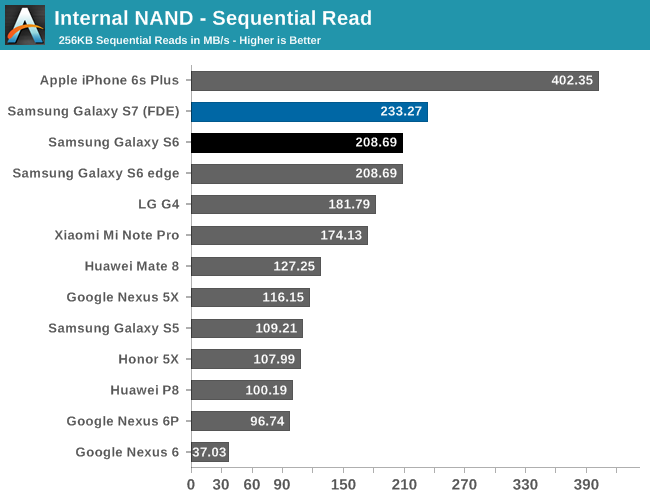
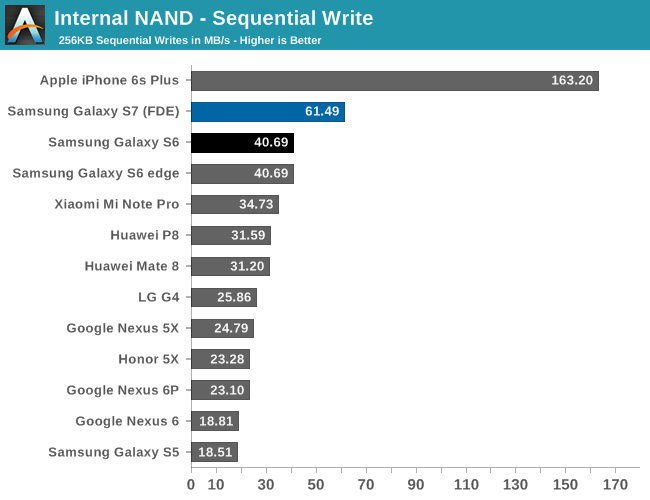
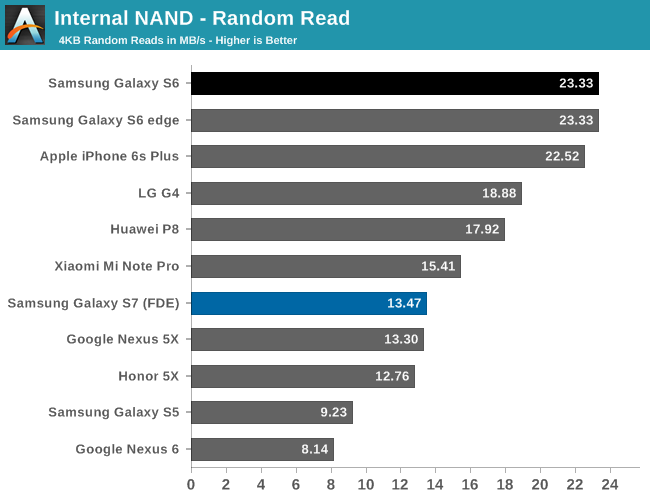
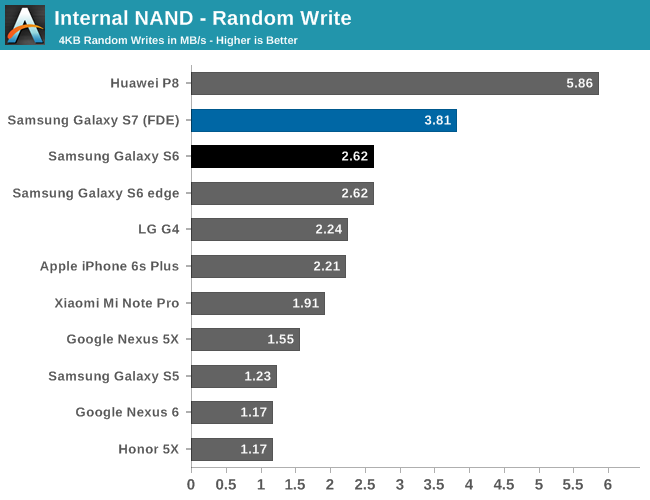
Looking at the performance results, we can also see that the Galaxy S7 is pretty similar to the Galaxy S6 in storage performance at a high level. Interestingly enough despite using full disk encryption on the Galaxy S7, we don’t really see a noticeable degradation in performance relative to the Galaxy S6 which is good to see considering the number of Android devices that do have noticeable performance effects when enabling FDE.










202 Comments
View All Comments
ah06 - Tuesday, March 8, 2016 - link
Samsung's core is already done I think, its the Mongoose core in the 8890, the one in the international variants. It's a slightly weaker core than KryoSpeedfriend - Tuesday, March 8, 2016 - link
A7 to A8 tock was 15%, and that was partly higher clock speed in a bigger body. Will be interesting to see what this tock brings.lilmoe - Tuesday, March 8, 2016 - link
Unlike what most reviewers want to believe, when designing application processor cores, companies like ARM, Qualcomm and Samsung aim for a "sweet spot" of load-to-efficiency ratios, not MAX single threaded performance.Their benchmark is common Android workloads (which btw, rarely saturates a Cortex A57 at 1.8GHz), since it's what makes the vast majority of the mobile application processor market. They measure the average/mean workload needs and optimize efficiency for that.
Android isn't as efficient as iOS and Windows Phone/10 Mobile in hardware acceleration and GPU compositing; it's much more CPU bound. It doesn't benefit as much from race to sleep in mobile devices. CPU cores remain significantly more active when rendering various aspects of the UI and scrolling.
tuxRoller - Tuesday, March 8, 2016 - link
Can you explain how you measure the relative "efficiencies" of the "hardware acceleration and GPU compositing"?lilmoe - Wednesday, March 9, 2016 - link
By measuring CPU and RAM utilization when performing said tasks. More efficient implementations would offload more of the work to dedicated co-processors, (in this case, the GPU) and would use less RAM.Generally, the more CPU utilization you need for these tasks, the less efficient the implementation. Android uses more CPU power and more RAM for basic UI rendering than iOS and WP/10M.
tuxRoller - Saturday, March 12, 2016 - link
How do you measure this so that you can ignore differences in the system (like textures chosen)? Then you'd have to make sure they're running on the same hardware.The best you can do is probably test Android and Windows on the same phone (this will put Windows at a bit of a disadvantage as Android allows very close coupling of drivers as their HAL is pretty permissive). Then you run a native game on each.
If you've found a way to do this I, and Google, would love to see the results.
Other than for 2d (which NOBODY, including directdraw/2d or quartz, fully accelerates), Google really hammers the GPU through use of shared memory, overlays and whatever else may be of use. There's obviously more optimization for them to do as they still overdraw WAY too much on certain apps, and they've obviously got a serious issue with their input latency, but it's a modern system. Probably the most modern as its been developed from scratch most recently.
Dobson123 - Tuesday, March 8, 2016 - link
In the 2016 web browsing battery life test, the S6 Edge is 20% worse than the S6, and the LG G4's number is also way too low.lilmoe - Tuesday, March 8, 2016 - link
I also thought the difference in battery life between the S6 and S6 Edge was off. They either posted wrong data, or something wrong happened while testing.MonkeyPaw - Tuesday, March 8, 2016 - link
I'd agree. When one of the phones goes from being upper middle of the pack on the old benchmark to being dead last--and woefully so--then I would have to wonder if something is really wrong with the new test. I've used the G4 for 6 months and have rarely had battery concerns over a day of "regular" use. I've owned several phones, and the G4 is a trooper.Ryan Smith - Tuesday, March 8, 2016 - link
We're re-checking the S6 Edge. We've had issues before with that specific phone.